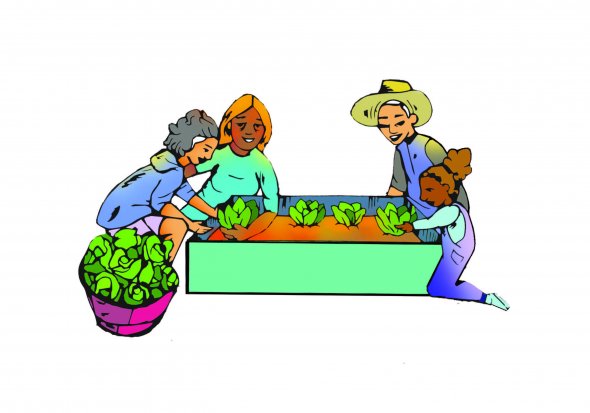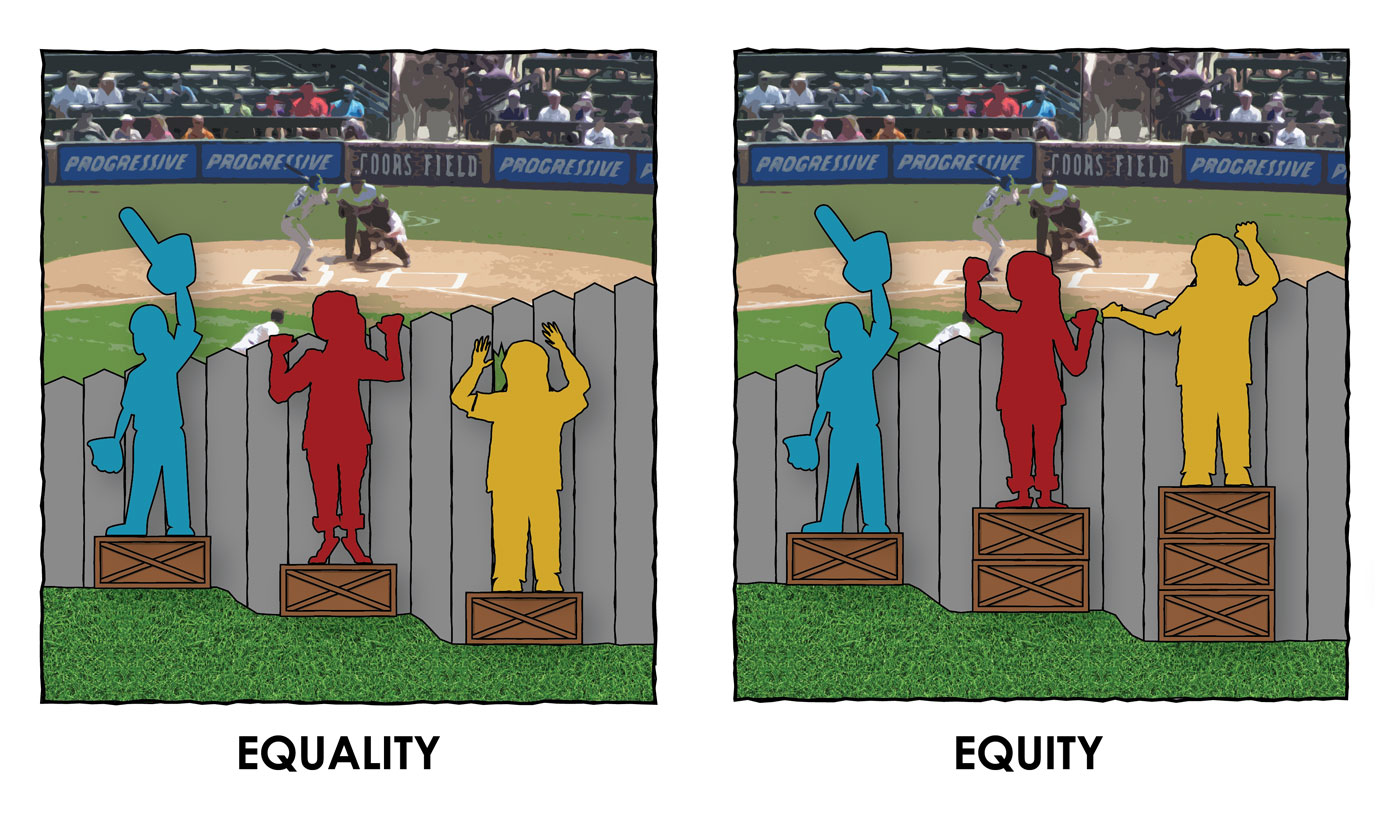
Create an Equitable School Community
“When a flower doesn’t bloom, you fix the environment in which it grows, not the flower.” – Alexander Den Heijer
What is this best practice area? Link to this section
An equitable school community supports each and every student and their families to receive the resources that they need, when they need them, and in a way that increases everyone feeling welcomed and valued.
Within SFUSD, education for everyone matters. We cannot be a great district until everyone is succeeding and getting what they need. It takes everyone to play a part in advocating for all students and families. Families with more resources and larger platforms especially, play a part in advocating for all families and students.
Creating an equitable school community is also about self-reflection. Families must be aware of their privilege and power, and it is important for families to hear and learn from perspectives that are different from their own.
It is important to know the difference between equality and equity. Equality means everyone gets the same resources. Some students, however, need different or more support and resources than others, often due to structural inequities. Similarly, ALL students need to have their identities affirmed and valued.

From Paul Kuttner’s “The problem with that equity vs. equality graphic you’re using.”
Make This Best Practice Area Come to Life Link to this section
1. Understand your positions of privilege and power. Link to this section
2. Connect with your child's teacher and school site administrator & advocate for all students. Link to this section
3. Talk to your children about race. Link to this section
Understand Your Positions of Privilege and Power Link to this section
As a family member, it is important to understand your own positions of privilege and power.
- Privilege in the U.S. shows up in many ways. It might look like having white skin, identifying as cisgender or straight, or having citizenship status.
- It is important that we acknowledge our various privileges-- and the way they build on one another-- so that we can better understand ourselves, and how our systems, like schools, work better for and are more welcoming towards privileged folks.
- It is also important to acknowledge our privilege so that we can be in better relationship with folks who do not hold the same privileges, and so that we can advocate for ALL students and families to be successful.
Please watch the following videos to better understand privilege and how you can use your privilege to advocate for others.
- What is Privilege? by As/Is
- Students Learn a Powerful Lesson About Privilege by BuzzfeedVideo
- Power, Privilege and Oppression by the University of Denver School of Social Work
(To translate these videos, please hover over the video, until you see the toolbar. Click on “CC” to turn on closed captioning. Then click the gear icon for “Settings,” scroll to and click “Subtitles/CC,” and then click “Auto-translate.” From there, you can scroll through the list of languages, and choose your preferred language.)
Connect with Your Child's Teacher and School Site Administrator & Advocate for All Students Link to this section
It takes everyone to play a part in advocating for all students and families. Families with more resources and larger platforms especially, play a part in advocating for all families and students.
- A great way to advocate for all families and students is to send an email or a letter to your child’s teacher and school site administrator asking reflective questions and sharing best practices, as it relates to creating an equitable school community. These best practices range from training staff in anti-bias, anti-racism practices, diversifying hiring practices, and implementing ethnic studies curriculum.
- Find an email/ letter template here:
-
Other languages coming soon!
- You will need your contacts’ email addresses or the mailing address of your child’s school. Simply copy and paste the text into your email, insert your information where prompted, cc both your child’s teacher and school site administrator, and then hit send (or print and send your letter through the mail!).
It is more powerful when these letters are signed and sent by more than one family. Please share this template with any of your friends who may also be interested, and you can also bring it to an SFUSD Parent Advisory meeting so you can raise your voices together. Find out more about Parent Advisory councils and committees here.
Talk to Your Children About Race
Link to this section
The following ten tips for talking to your children about race come from Embrace Race.
You can also visit this webpage to find more family resources for "Talking about Race & Social Justice in the U.S." from SFUSD.
Start Early
By 6 months of age babies are noticing racial differences; by age 4, children have begun to show signs of racial bias. Let your child know that it’s perfectly okay to notice skin color and talk about race. Start talking about what racial differences mean and don’t mean.
Encourage Your Child
Encourage your child to ask questions, share observations and experiences, and be respectfully curious about race.
Expose your child to different cultural opportunities – photographs, films, books, or cultural events, for example – and discuss the experience afterwards.
You don’t have to be an expert on race to talk with our child. Be honest about what you don’t know and work with your child to find accurate information.
Be Mindful
What kids hear from us is less important than what they see us do.
You are a role model to your child. What you say is important, but what you do - the diversity of your friendship circle, for example - is likely to have a bigger impact.
If your child doesn’t attend a diverse school, consider enrolling them in after-school or weekend activities such as sports leagues that are diverse if you’re able. Choose books and toys that include persons of different races and ethnicities. Visit museums with exhibits about a range of cultures and religions.
Face and Know Your Own Bias
Let your child see you acknowledge and face your own biases.
We’re less likely to pass on the biases we identify and work to overcome.
Give your child an example of a bias, racial or otherwise, that you hold or have held. Share with your child things you do to confront and overcome that bias.
Know and Love Who You Are
Talk about the histories and experiences of the racial, ethnic, and cultural groups you and your family identify with. Talk about their contributions and acknowledge the less flattering parts of those histories as well.
Tell stories about the challenges your family (your child’s parents, aunts and uncles, grandparents and great grandparents, others) has faced and overcome.
Develop Racial Cultural Literacy
Develop racial cultural literacy by learning about and respecting others.
Study and talk about the histories and experiences of groups we call African Americans, Latinos, Asian Americans, Native Americans, and whites, among others.
Be sure your child understands that every racial and ethnic group includes people who believe different things and behave in different ways . There is as much diversity within racial groups as across them.
Be Honest
Be honest with your child, in age-appropriate ways, about bigotry and oppression.
Children are amazing at noticing patterns, including racial patterns (who lives in their neighborhood versus their friends' neighborhoods, for example). Help them make sense of those patterns, and recognize that bigotry and oppression are sometimes a big part of those explanations.
Be sure your child knows that the struggle for racial fairness is still happening and that your family can take part in that struggle.
Tell Stories
"Lift up the freedom fighters ": Tell stories of resistance and resilience.
Every big story of racial oppression is also a story about people fighting back and "speaking truth to power." Teach your child those parts of the story too.
Include women, children and young adults among the "freedom fighters" in the stories you tell. A story about racial struggle in which all the heroes are men wrongly leaves many people out.
Be Active
Be active - don't be a "bystander" on race.
Help your child understand what it means to be, and how to be, a change agent.
Whenever possible, connect the conversations you're having to the change you and your child want to see, and to ways to bring about that change.
Plan for a Marathon, Not a Sprint
It's okay to say, "I'm not sure" or "Let's come back to that later, okay?" But then do come back to it.
Make race talks with your child routine. Race is a topic you should plan to revisit again and again in many different ways overtime.
Other District Resources Link to this section
Get Involved
Find opportunities to get more involved with your school or with the district as a whole.
- Join your school's School Site Council to help set your school's priorities and budget.
- Attend Board of Education meetings in person or online.
- Join a family organization such as an Advisory Council, English Learner Advisory Committee or the African American Parent Advisory Committee. Find other advisory councils and committees.
SFUSD Office of Equity: https://www.sfusd.edu/equity-and-title-ix-office-recourses
This page was last updated on February 27, 2024

